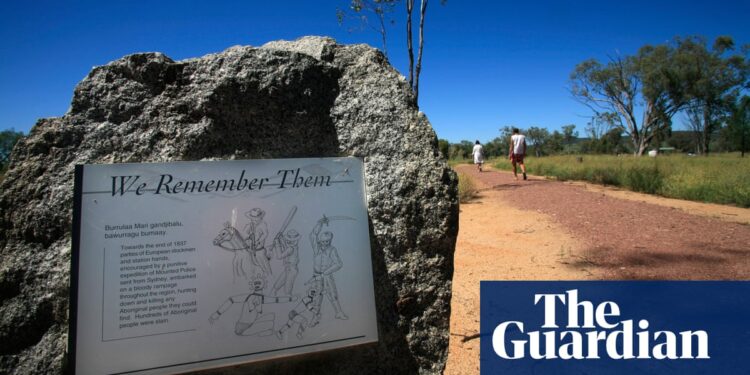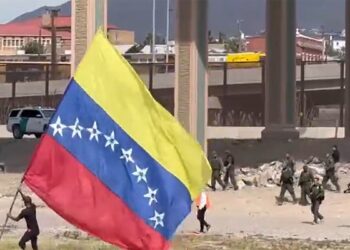The final findings of the “horrendous” eight-year long “massacre map”, tracing the violent history of the Australian colonial frontier have been released.
The Colonial Frontier Massacres Digital Map Project, spearheaded by the late emerita professor of history at the University of Newcastle, Dr Lyndall Ryan, officially concluded in 2022.
Since then, researchers have reviewed every site on the map, with contributions from the general public, volunteers and peer reviewers. Much of the rest of the work on the map was completed by professional and academic staff without pay.
In this thorough, final check of archival sources, some sites have been added and others merged, others have more accurate location data and more details have been provided in the narrative section.
Guardian Australia collaborated with the university team to produce The Killing Times, a long-running series telling the stories of all sides of Australian frontier history.
The project found that:
-
At least 10,657 people were killed in at least 438 colonial frontier massacres.
-
10,374 of them were Aboriginal or Torres Strait Islander people killed by colonists.
-
Only 160 of those killed were non-Indigenous colonists.
-
There were 13 massacres of colonists by Aboriginal or Torres Strait Islander people.
-
The most intense period of massacres was from the late 1830s into 1840s, with a pivotal point being the Myall Creek massacre in 1838 – the first time any perpetrators had been punished.
-
After the Myall Creek convictions, the government could no longer involve the military and new “police” forces were created, which set a pattern for the rest of the conflict.
-
About half of all massacres of Aboriginal people were carried out by police and other government agents. Many others were perpetrated by settlers acting with tacit approval of the state.
-
Some perpetrators were involved in many massacres.
“For some [perpetrators], you can see a life trajectory where, for example, one was raised in an area where colonists had been killed and fighting had been especially intense in Queensland, and went on to commit massacres and other violence right across the Northern Territory,” digital humanities specialist on the project, Dr Bill Pascoe, says.
The work to produce the map was painstaking and thorough.
“ I sourced thousands of newspaper articles, government documents and other materials which contained horrendous stories of violence,” says Dr Jennifer Debenham, who worked alongside Ryan on the project from the beginning.
“Massacre happens all over the world and throughout history, however it is our responsibility to acknowledge the violence of the dispossession that took place here which has given us the tremendous privileges we presently enjoy.”
The project defined a colonial frontier massacre as the deliberate killing of six or more relatively undefended people in one operation. It did not include the many documented killings of fewer than six people in incidents on the frontier, so the numbers generated are very cautious lower estimates.
There were likely many more killed, Pascoe says, “but we had to limit ourselves or we would never have finished. It was a huge task. Finalising this work and making a stable version of the data available in an archive means other researchers can build on it and answer these and many other questions,” he says.
The work has changed our understanding of history in Australia, Pascoe says.
“Back in the 80s and 90s it was possible for people to argue that the frontier wasn’t so violent, and for them to be believed. Nobody can argue that point any more. Anybody can go and read the evidence for themselves. It’s time to move on to the next step – now that we know that these events happened, we need to understand more about them,” he says.
Pascoe says the team has welcomed feedback and criticism as an important part of the research.
“The academic process is a dialogue that welcomes criticism in order to get closer to the truth. We researched and presented the information and welcomed feedback, including the negative, and over time have improved and updated our knowledge. It’s truth-telling and listening,” he says.
West Australian historian and author Dr Chris Owen has written extensively on the frontier in his home state. Owen worked on the map for years as a volunteer. He says the conspiracy of silence was profound, and made it hard to get a true picture of the violence perpetrated in WA.
“As the Western Australian researcher and as an experienced researcher this project was exceptionally difficult in finding verifiable evidence in an area where it was intentionally hidden,” Owen says.
“The all-pervasive ‘conspiracy of silence’ among the local colonist community, where no man would incriminate another or risk retribution, only exacerbated the difficulty in research.”
The violence of these events made the work “horrendous”, Northern Territory-based historian Dr Robyn Smith says.
“This was a horrendous research experience, but it did expose the ugly underbelly of settler colonialism in Australia,” Smith says.
“In what is arguably the least understood, nevermind least studied, part of the country, evidence of sustained, systemic sexual, paramilitary and civilian violence abounds.
“Contemporary northern Australia reflects that history and its society honours many of the perpetrators. The evidence is there. The truth has been told; people need to listen,” Smith says.
Ryan’s monumental contribution to Australian history was recognised with a posthumous AO in the 2025 Australia Day honours list. Ryan did not live to see the map complete, but Smith says her legacies are “myriad” – among them her determination to rebut the denialism of frontier violence.
“I acknowledge enormous bias when I claim that this project is arguably her greatest,” Smith says. “She was enormously driven. And she was right.”
-
In Australia, the crisis support service Lifeline is on 13 11 14. In the UK Samaritans can be contacted on 116 123. In the US, the National Suicide Prevention Lifeline is 1-800-273-8255. Other international suicide helplines can be found at befrienders.org
-
The Killing Times is based on data from the Colonial Frontier Massacres Digital Map Project led by Prof Lyndall Ryan at the University of Newcastle’s Centre for the 21st Century Humanities.
-
For more information about the analysis conducted by Guardian Australia and the research methods of the University of Newcastle’s colonial frontier massacres research team, please read the “About” section here.







